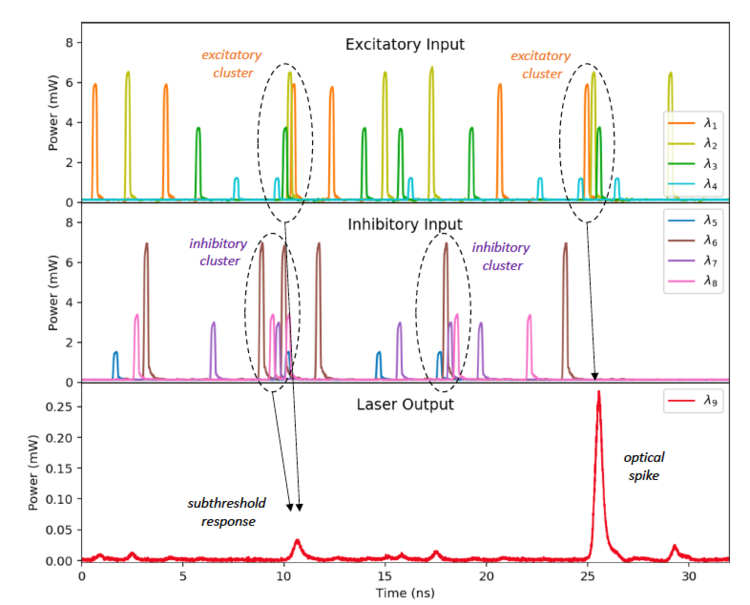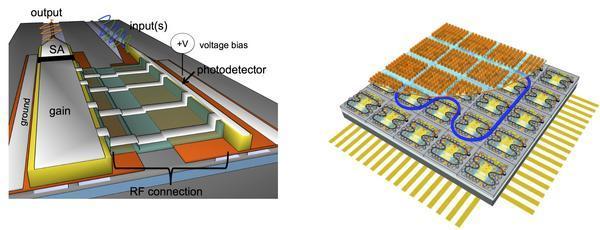Description:
Neuromorphic photonics is an emerging field at the intersection of photonics and neuromorphic engineering, with the goal of producing accelerated processors that combines the information processing capacity of neuromorphic processing architectures and the speed and bandwidth of photonics. This project is about understanding and building photonic spiking neural networks with a particular focus on photonic integrated circuits. We study the first results of a novel device, an excitable laser on a PIC platform. It is able to emulate the key properties of the leaky integrate-and-fire (LIF) neuron model and exhibits many favorable features for scalability, energy efficiency, and high-speed spike processing.
Figure below:

Top left: Topographic micrograph of an integrated laser neuron. Excitatory and inhibitory inputs are incident on a balanced photodetector (PD) pair, which drives a distributed feedback (DFB) laser biased with current Ip.
Top right: Excitatory and inhibitory dynamics in multi-channels.
Bottom: Architecture of Photonic Spiking Neural Networks.
Photonic Spike Processing

(Left) An illustration of a hypothetical 'laser neuron' that emulates the key features of biological spiking neurons. The device occupies an area that is a fraction of a square millimeter. Thousands of devices could potentially be printed onto a single chip. (Right) An illustration of what a large-scale chip might look like. Lasers (orange layer) are connected together via photonic waveguides (blue and gray) while electronic circuitry (yellow) controls stability, self-healing, and learning.

Our laser model exhibits the same behavior as the 'Leaky Integrate-and-Fire model' on time scales that are millions of times faster. Techniques based on wavelength division multiplexing (WDM) would allow each processor to connect to hundreds of others simultaneously without the corresponding degradation in speed typically observed in electronics.
We are developing a bio-inspired “photonic spike processor" that exploits the fast dynamics of lasers and photonic resonators to perform computations at extremely high speeds and bandwidths. This paradigm, inspired by spiking neural networks and adapted to take advantage of ultrafast and low energy phenomena in photonic devices, has the potential for orders of magnitude performance improvement over current processing systems. This encoding scheme has both analog and digital qualities, and, via careful interleaving of the two representations, is potentially capable of achieving the high performance and low power characteristics of analog systems while simultaneously being cascadable and scalable. Applications include real-time analysis/assurance of complex systems, simulation of emergent behavior, and low-latency intelligent control, processing challenges that appear in a wide variety of high-value, time critical environments. Our approach will exploit both function-oriented models in optoelectronics and integrated interconnection strategies based on fiber optical networking.
Book Chapters
A. N. Tait, M. A. Nahmias, Y. Tian, B. J. Shastri, and P. R. Prucnal, “Photonic Neuromorphic Signal Processing and Computing,” in Nanophotonic Information Physics, Springer-Verlag Berlin Heidelberg, 2013, ch. 8, 40 pages (in press).
Journal Papers
A. N. Tait, M. A. Nahmias, B. J. Shastri, and P. R. Prucnal “Broadcast and weight: an integrated network for scalable photonic spike processing,” IEEE/OSA Journal of Lightwave Technology, vol. 32, no. 21, pp. 3427–3439, Nov. 2014.
B. J. Shastri*, A. N. Tait*, M. A. Nahmias*, and P. R. Prucnal, “Photonic spike processing: ultrafast laser neurons and an integrated photonic network,” IEEE Photonics Society Newsletter, vol. 28, no. 3, Jun. 2014. [*equal contribution]
M. A. Nahmias, B. J. Shastri, A. N. Tait, and P. R. Prucnal, “A leaky integrate-and-fire laser neuron for ultrafast cognitive computing,” IEEE Journal of Selected Topics in Quantum Electronics, vol. 19, no. 5, pp. 1800212, Sep.-Oct. 2013.
Conference Papers
M. A. Nahmias*, B. J. Shastri*, A. N. Tait, N. Kunapuli, and P. R. Prucnal, “Resonant excitable switching with graphene,” in Proc. IEEE Photonics Conference (IPC), San Diego, CA, USA, Oct. 2014, paper ThB1.4, pp. 577–578. [*equal contribution]; IEEE Photonics Conference Student Paper (third place).
B. J. Shastri, A. N. Tait, M. A. Nahmias, B. Wu, B. Romeira, and P. R. Prucnal, “Spatiotemporal pattern recognition with cascadable graphene excitable lasers,” in Proc. IEEE Photonics Conference (IPC), San Diego, CA, USA, Oct. 2014, paper ThB1.2, pp. 573–574.
M. A. Nahmias, A. N. Tait, B. J. Shastri, and P. R. Prucnal, “Recent progress towards a fully-integrated hybrid silicon laser neuron platform,” in Proc. International Symposium on Nonlinear Theory and its Applications (NOLTA), Luzern, Switzerland, Sep. 2014, paper C2L-B3-6236, pp. 503–506.
A. N. Tait and P. R. Prucnal. “Applications of wavelength-fan-in for high-performance distributed processing systems,” in Proc. IEEE/ACM Int. Symposium on Nanoscale Architectures (NANOARCH 2014), Paris, France, Jul. 2014, pp. 177–178.
B. J. Shastri, A. N. Tait, M. A. Nahmias, B. Wu, B. Romeira, and P. R. Prucnal, “Bistable spiking circuit with graphene excitable laser for cascadable photonic logic,” in Proc. IEEE Summer Topicals Meeting Series, Montreal, QC, Canada, Jul. 2014, paper TuD2.4, pp. 108–109.
B. J. Shastri, A. N. Tait, M. A. Nahmias, B. Wu, and P. R. Prucnal, “Coincidence detection with graphene excitable laser,” in Proc. Conference on Lasers and Electro-Optics (CLEO), San Jose, CA, USA, Jun. 2014, paper STu3I.5.
M. A. Nahmias, A. N. Tait, B. J. Shastri, and P. R. Prucnal, “O-BAR: A scalable, optical neuromorphic communication protocol,” in Proc. IEEE Optical Interconnects Conference (OI), Coronado Bay, CA, USA, May 2014, paper TuP14.
A. N. Tait, M. A. Nahmias, B. J. Shastri, and P. R. Prucnal, “Broadcast-and-weight interconnects for integrated distributed processing systems,” in Proc. IEEE Optical Interconnects Conference (OI), Coronado Bay, CA, USA, May 2014, paper WA3.
B. J. Shastri, M. A. Nahmias, A. N. Tait, Y. Tian, B. Wu, and P. R. Prucnal, “Graphene excitable laser for photonic spike processing,” in Proc. IEEE Photonics Conference (IPC), Seattle, WA, USA, Sep. 2013, paper PD.4; post deadline paper.
M. A. Nahmias, A. N. Tait, B. J. Shastri, and P. R. Prucnal, “An evanescent hybrid silicon laser neuron,” in Proc. IEEE Photonics Conference (IPC), Seattle, WA, USA, Sep. 2013, paper ME3.4, pp. 93–94.
B. J. Shastri, M. A. Nahmias, A. N. Tait, Y. Tian, M. P. Fok, M. P. Chang, B. Wu, and P. R. Prucnal, “Exploring excitability in graphene for spike processing networks,” in Proc. IEEE Numerical Simulation of Optoelectronic Devices (NUSOD), Vancouver, BC, Canada, Aug. 2013. paper TuC5.
Invited Talks
B. J. Shastri, “Photonic neuromorphic spike processing for ultrafast cognitive computing,” IEEE North Jersey Section Computer Chapter and Signal Processing Chapter, Teaneck, NJ, USA, Sep. 2013.
B. J. Shastri, “Photonic neuromorphic spike processor for ultrafast and low energy cognitive computing,” Bell Labs/Alcatel-Lucent Green ICT Summit, Murray Hill, NJ, USA, Jan. 2013.
P. R. Prucnal, “Photonic Neuromorphic Signal Processing and Computing,” International Workshop on Information Physics and Computing in Nano-scale Photonics and Materials (IPCN), Orleans, France, Sep. 7, 2012.
Group Members:
- Mitchell Nahmias
- Alex Tait
- Bhavin Shastri
- Matt Chang
- Paul Prucnal
